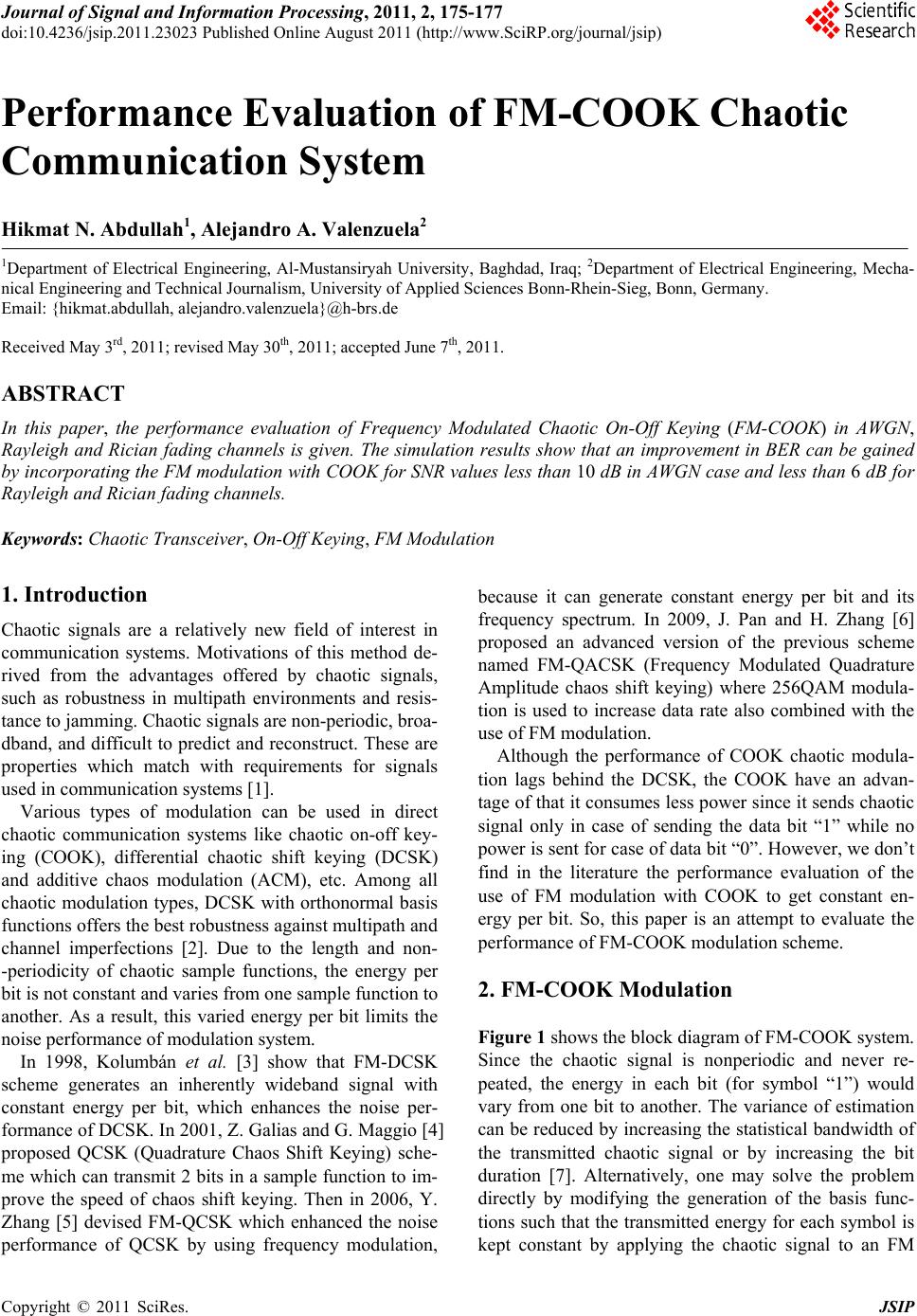
Journal of Signal and Information Processing, 2011, 2, 175-177
doi:10.4236/jsip.2011.23023 Published Online August 2011 (http://www.SciRP.org/journal/jsip)
Copyright © 2011 SciRes. JSIP
175
Performance Evaluation of FM-COOK Chaotic
Communication System
Hikmat N. Abdullah1, Alejandro A. Valenzuela2
1Department of Electrical Engineering, Al-Mustansiryah University, Baghdad, Iraq; 2Department of Electrical Engineering, Mecha-
nical Engineering and Technical Journalism, University of Applied Sciences Bonn-Rhein-Sieg, Bonn, Germany.
Email: {hikmat.abdullah, alejandro.valenzuela}@h-brs.de
Received May 3rd, 2011; revised May 30th, 2011; accepted June 7th, 2011.
ABSTRACT
In this paper, the performance evaluation of Frequency Modulated Chaotic On-Off Keying (FM-COOK) in AWGN,
Rayleigh and Rician fading channels is given. The simulation results show that an improvement in BER can be gained
by incorporating the FM modulation with COOK for SNR values less than 10 dB in AWGN case and less than 6 dB for
Rayleigh and Rician fading channels.
Keywords: Chaotic Transceiver, On-Off Keying, FM Modulation
1. Introduction
Chaotic signals are a relatively new field of interest in
communication systems. Motivations of this method de-
rived from the advantages offered by chaotic signals,
such as robustness in multipath environments and resis-
tance to jamming. Chaotic signals are non-periodic, broa-
dband, and difficult to predict and reconstruct. These are
properties which match with requirements for signals
used in communication systems [1].
Various types of modulation can be used in direct
chaotic communication systems like chaotic on-off key-
ing (COOK), differential chaotic shift keying (DCSK)
and additive chaos modulation (ACM), etc. Among all
chaotic modulation types, DCSK with orthonormal basis
functions of fers th e be st robustn ess ag ainst multip ath an d
channel imperfections [2]. Due to the length and non-
-periodicity of chaotic sample functions, the energy per
bit is not constant and varies from one sample function to
another. As a result, this varied energy per bit limits the
noise performance of modulation system.
In 1998, Kolumbán et al. [3] show that FM-DCSK
scheme generates an inherently wideband signal with
constant energy per bit, which enhances the noise per-
formance of DCSK. In 2001, Z. Galias and G. Maggio [4]
proposed QCSK (Quadrature Chaos Shift Keying) sche-
me which can transmit 2 bits in a sample function to im-
prove the speed of chaos shift keying. Then in 2006, Y.
Zhang [5] devised FM-QCSK which enhanced the noise
performance of QCSK by using frequency modulation,
because it can generate constant energy per bit and its
frequency spectrum. In 2009, J. Pan and H. Zhang [6]
proposed an advanced version of the previous scheme
named FM-QACSK (Frequency Modulated Quadrature
Amplitude chaos shift keying) where 256QAM modula-
tion is used to increase data rate also combined with the
use of FM modulation.
Although the performance of COOK chaotic modula-
tion lags behind the DCSK, the COOK have an advan-
tage of that it consumes less pow er since it sends chaotic
signal only in case of sending the data bit “1” while no
power is sent for case of data bit “0”. However, we don’t
find in the literature the performance evaluation of the
use of FM modulation with COOK to get constant en-
ergy per bit. So, this paper is an attempt to evaluate the
performance of FM-COOK modulation scheme.
2. FM-COOK Modulation
Figure 1 shows the block diagram of FM-COOK system.
Since the chaotic signal is nonperiodic and never re-
peated, the energy in each bit (for symbol “1”) would
vary from one bit to another. The variance of estimation
can be reduced by increasing the statistical bandwidth of
the transmitted chaotic signal or by increasing the bit
duration [7]. Alternatively, one may solve the problem
directly by modifying the generation of the basis func-
tions such that th e transmitted energy for each symbol is
kept constant by applying the chaotic signal to an FM